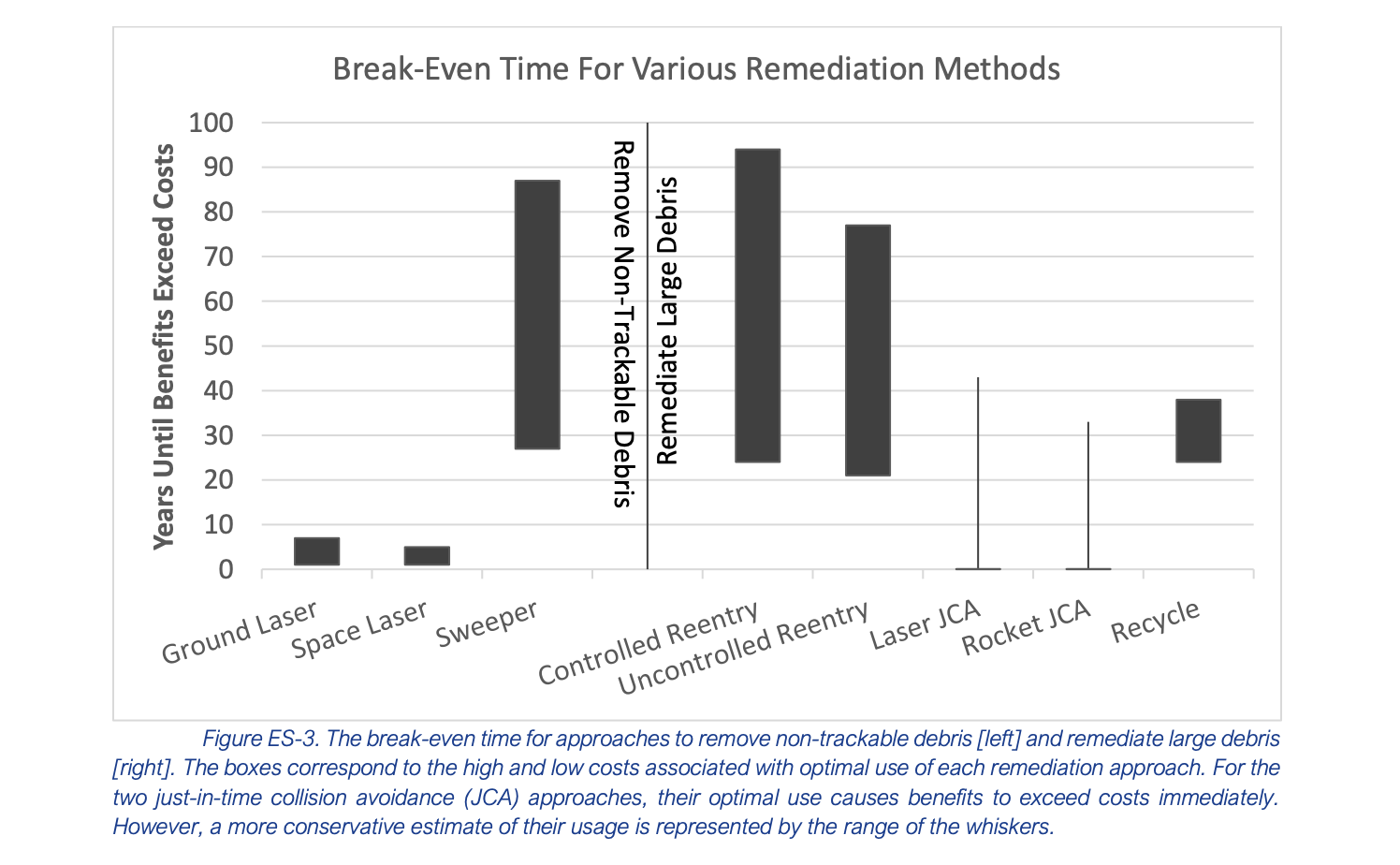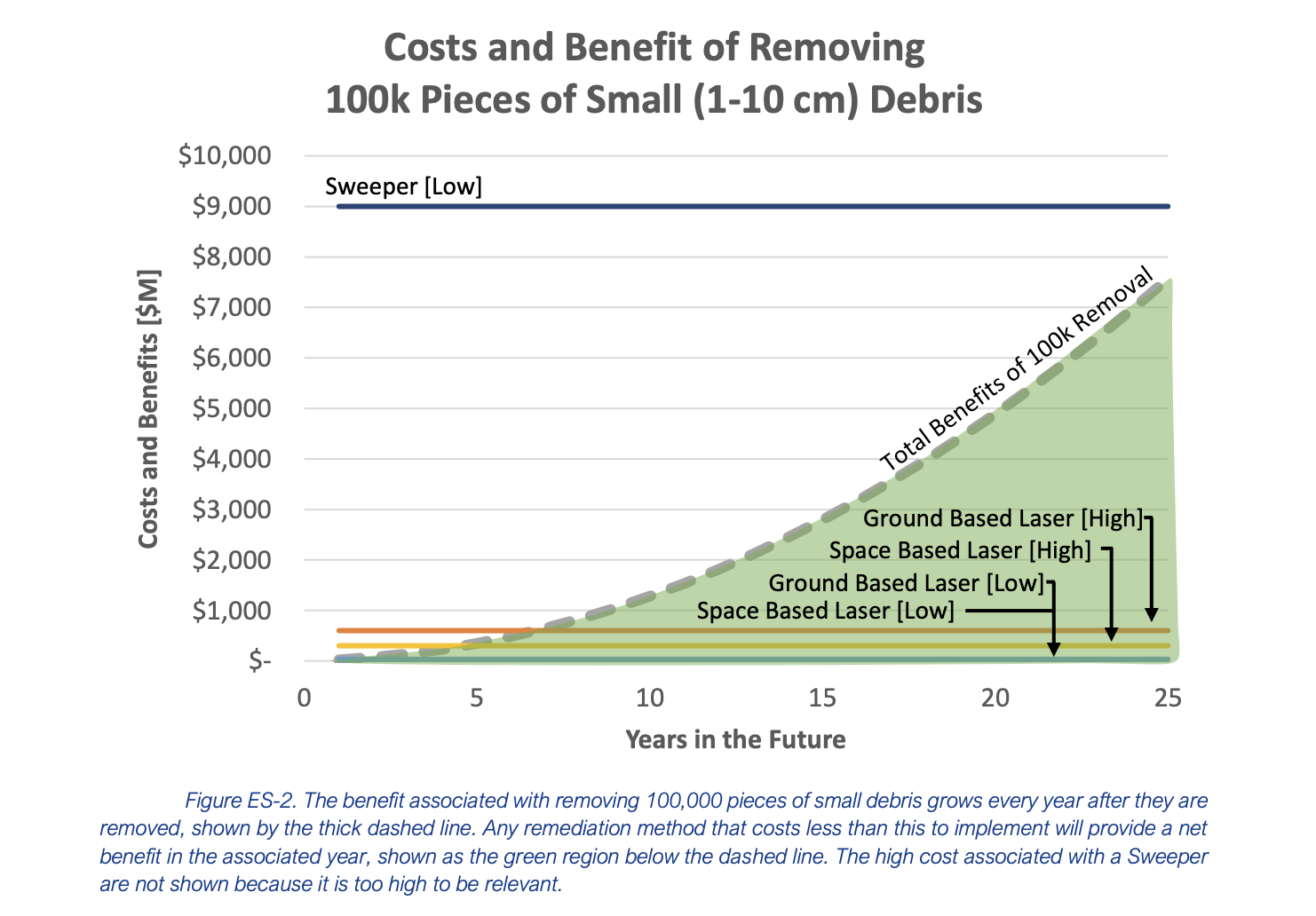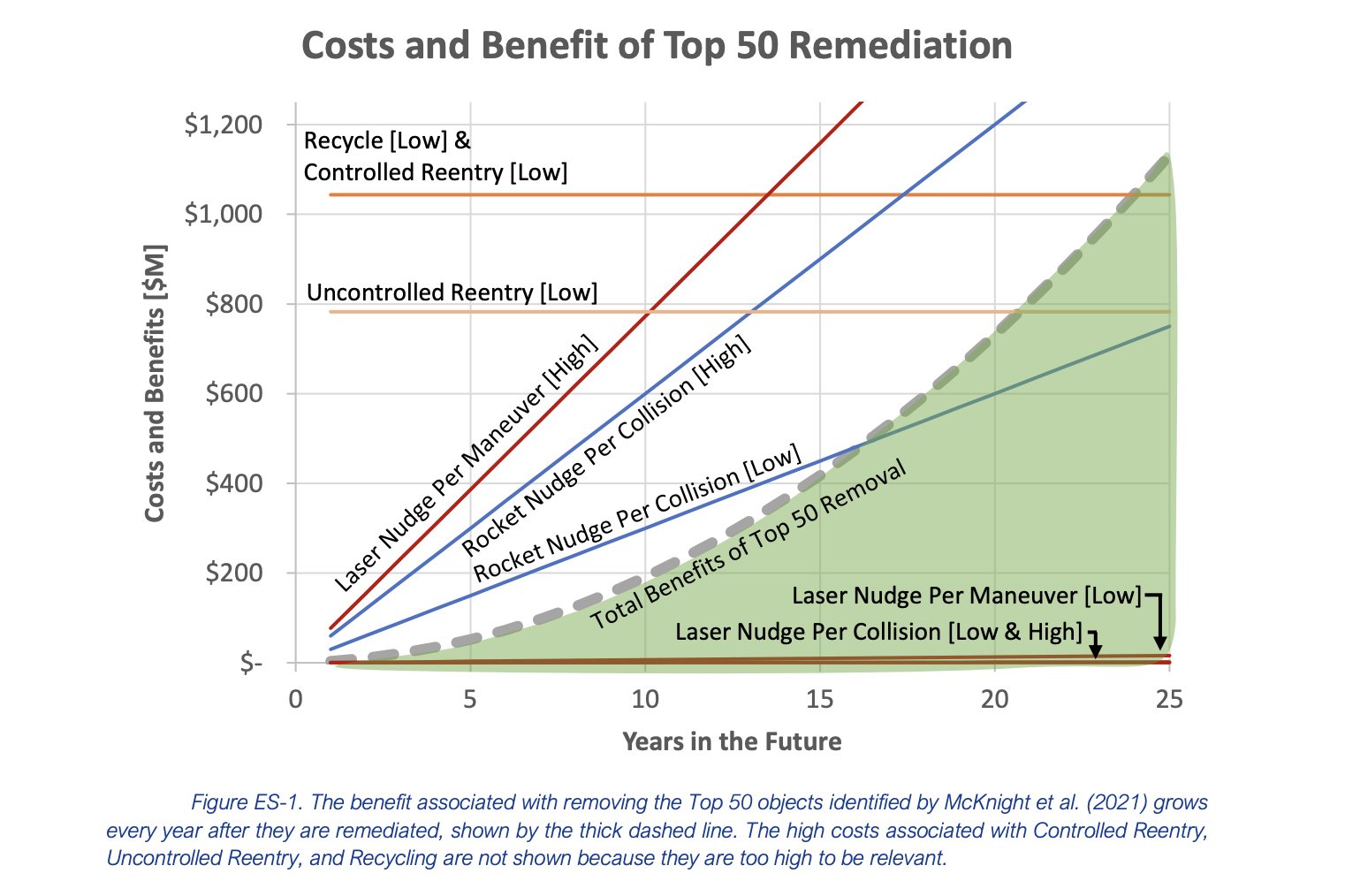
How do you clean up 170 million pieces of space junk?
In March, NASA released the most comprehensive financial analysis on space debris. For the first time, this report illuminates the financial costs and benefits of various paths forward to combat one of the fastest-growing dangers in Earth’s orbit.
The space economy is enormous, but one of its biggest challenges is tiny: space debris, where a collision with an object the size of even a nickel can cause catastrophic damage. More objects are being placed into orbit now than at any point in history. This increases the chance of collisions between satellites and existing debris. There have been varying approaches to managing and mitigating debris, ranging from legislative/regulatory efforts to technological ones.
With increased activity in space, debris is a growing threat to Low Earth Orbit (LEO), the most accessible area of space. There may be as many as 170 million pieces of debris in orbit, with the vast majority too small to track due to limits in current technology, but no less dangerous. Of the 55,000 pieces of debris that we can track, more than 27,000 objects, like spent rocket boosters, active satellites, and dead satellites, are monitored by the Department of Defense’s global Space Surveillance Network (SSN).
Due to the speed at which objects move in LEO (around 17,000 mph), the impact of even a small object, like a ping pong ball, can cause significant damage or completely shatter existing infrastructure, producing more fragments of trackable and detectable size. Twice in the last month, the International Space Station had to perform maneuvers to dodge collisions. Besides immediate LEO congestion, the risk of Kessler Syndrome, in which current debris creates a growing and self-replicating cascade of orbital junk, is also a growing possibility. Political leaders have begun to pay attention: Sen. John Hickenlooper (D-CO)–one of the leaders in Congress on this issue–has said “Because of the threats from debris already in orbit, simply preventing more debris in the future is not enough.”
Methods of Mitigation
Technological efforts to limit debris include making reusable rockets and maneuverable satellites. Certain satellites can adjust their position through a satellite operator, a person or entity that manages a satellite. For example, the International Space Station performed what is called an in-orbit maneuver to dodge debris. To meet the needs of clean-up, industries have developed debris-cleaning tech like ground laser nudges, space tugs, and space lasers. Policy has not kept pace with the rapid growth of the emerging commercial space industries. Industries are also hesitant to use and effectively implement new technologies because costs have been uncertain.
There has never been a comprehensive cost-benefit analysis of debris clean-up (remediation) methods despite robust data on the number of objects in space being available. This new NASA analysis provides the cost of tech and the time to recover the costs, giving industries a better idea of how to implement new technologies effectively.
To create the report, NASA scientists created a model that specified the economic risks space debris imposed on satellite operators based on the time it takes to match the cost put into clean up, and the method of cleanup used. Scientists then applied the model to two scenarios: prioritizing large debris breakdown and debris removal (aka getting rid of the top 50 largest and most-concerning objects in space) and targeting small debris removal (eliminating 100,000 pieces of debris from 1–10 cm in size).
Different Methods of Debris Management Technology
| Debris Management Method | Application to Debris Size | Description | Estimated Cost (Low) | Estimated Cost (High) | Development Costs |
|---|---|---|---|---|---|
| Tug for Controlled Reentry | Large (≥10 cm ) | Catch an object and adjust its orbit so it re-enters the atmosphere at a specific angle to concentrate debris falloff in a concentrated area. | ~$4,000 per kilogram | ~$60,000 per kilogram | n/a |
| Tug for Uncontrolled Reentry | Large (≥10 cm) | Catch an object and adjust its orbit so it re-enters the atmosphere freely with no predesignated fall area and unclear reentry timing. | ~$3,000 per kilogram | ~$40,000 per kilogram | n/a |
| Ground Laser Nudges | Large (≥10 cm), Small debris (1 cm–10 cm) | Uses a laser to move an object without physical contact from the surface of the Earth. Requires a lot of energy. | ~$300 per kilogram | ~$6,000 per kilogram | ~$600 million |
| Space Laser Nudge | Large (≥10 cm), Small debris (1 cm–10 cm) | Uses a laser to move an object without physical contact from space. Uses less energy from ground-based lasers since much of the energy won’t be lost going through the atmosphere. | ~$300 per kilogram | ~$3,000 per kilogram | ~$300 million |
| Just-in-time collision avoidance (JCA) via Laser Nudges | Large (≥10 cm) | Used to prevent predicted collisions between large pieces of orbital debris, like satellites and debris by informing laser nudges. | Between $6 for 100 kg object- $500 for 9,000 kg object per maneuver | Between $700 for 100 kg object- $60,000- for 9,000 kg object per maneuver | n/a |
| Just-in-time collision avoidance (JCA) via Rapid Response Rockets | Large (≥10 cm) | Used to prevent predicted collisions between large pieces of orbital debris, like satellites and debris by informing Rapid Response Rockets(RRR). These rockets would meet with specific debris and alter the target debris’ orbit. | $30 million per nudge | $60 million per nudge | n/a |
| Physical Sweeping | Large (≥10 cm), Small debris (1 cm–10 cm) | Directly impacting debris to move or relocate. | $90,000 per kilogram | $900,000 per kilogram | $90,000 million |
| Recycling Debris | Large (≥10 cm) | Gathering and processing debris and processing it in space to use as fuel or other utilities. | ~$1.4 billion at 15,000/kg | n/a | n/a |
Three Key Findings
Finding 1. To reduce operator risks, small debris should be removed, and large debris should be nudged to prevent collisions.
Even though it is initially expensive, removing small debris would produce a net benefit in under a decade:

Initial investment can be made up quickly and have a large impact.

Initial investment can be made up quickly and have a large impact.
NASA’s models indicate that debris removal efforts for non-trackable debris can have immediate benefits. For trackable debris, it would take just 3-4 years to make up initial costs.
Finding 2. Spacecraft operators can recover the initial upfront cost quickly using reusable technologies that clean up debris using controlled and uncontrolled reentry.

The benefit associated with removing large objects grows every year after they are remediated.
For the 50 largest objects in space, which can be effectively removed using controlled re-entry, especially when done using reusable vehicles, cost recovery would be seen in around three decades.
Finding 3. Recycling space debris does not provide overwhelmingly clear enough financial benefits over other debris cleanup methods.
While there are potential economic and climate benefits to recycling space debris, recycling in space reduces the risk of harmful chemicals being released into the upper atmosphere as it burns upon reentry and limits the amount of debris remnants in the upper atmosphere.
Investing in debris recycling facilities has a large upfront cost, and it is not guaranteed that a market for such facilities will emerge in the next decade. This makes projections for the value of recycling uncertain. The report indicates, however, that debris recycling is a potential solution to long-term efforts of debris management. This can be done through in-space manufacturing and assembly (ISAM), a practice that involves factories and utility services in space and covers servicing, assembly, and manufacturing. These facilities can be used to collect and recycle billions of dollars worth of space debris and help create a “circular space economy” to process, recycle, build, and refuel space infrastructure using existing debris.
Three Solutions
We have ideas that have already been contributed to address space debris. A Day One Project contributor Lyndsey Grey outlined five policy solutions to space debris remediation. Highlighted below are the three most relevant ones below:
Recommendation 1. NASA’s Orbital Debris Program Office (ODPO), in coordination with the DOD’s Space Surveillance Network, should create a prioritized list of massive space debris items in LEO for expedited cleanup.
This is a strong start. Creating a list of large debris (>10 cm) by impact and prioritizing nudging large debris like non-functioning satellites, spent rocket stages, and other large debris using ground lasers will allow increased benefits for less cost. Additionally, NASA should prioritize destroying non-trackable and other small debris.
Their report finds that remediating smaller debris not only demonstrates results faster but is a lighter financial lift. Surveying debris size and impact can be done alongside removing smaller debris, maximizing impact.
Recommendation 2. The Space Force, in collaboration with the Department of Commerce (DOC), should fund removal and/or recycling of a set number of large debris objects each year, thereby creating a reliable market for space debris removal.
We recommend that the nascent Space Force and Department of Commerce provide funding for technical solutions to remove and recycle larger debris objects. If we are to tackle the space debris problem at all, we need funding. The amount of large debris is already extensively cataloged. This is doable with the completion of a trackable list of large debris from Recommendation 1.
NASA’s report provides cost information for energizing emerging space industries to start investing in debris removal tools and infrastructure to maximize impact. NASA states the projected upfront/upkeep costs of recycling debris along and the costs of removing large debris. Since more money can be saved through nudges and can still meaningfully prevent collisions, this can provide room for developing ISAM capabilities for recycling.
Recommendation 3. NOAA’s Office of Space Commerce, in conjunction with the Space Force and NASA’s ODPO, should jointly issue an annual research report outlining risk, cost-benefit analyses, and the economics of orbital debris removal and recycling.
Having a regular cost-benefit analysis can help businesses assess the scope of their own recycling and space debris cleanup efforts. NASA’s cost-benefit analysis is aligned with the intention of this recommendation. NASA’s report also serves as a good foundation for future recurring analysis.
What Next?
Space debris isn’t going to go away, but we can start minimizing the threat it poses.
The NASA report indicates that taking action immediately will have minimal financial drawbacks, with a high debris-cleaning impact within a few years. Technologies like ground and space laser nudges provide low-cost alternatives to other debris mitigation methods currently in use. The report also provides insight into industries’ understanding of the true financial costs associated with cleaning space debris. This can incentivize innovation and create even more cost-effective technologies to manage and clean up debris. There is also an immediate need to address the space debris problem: existing U.S. government and commercial infrastructure (the International Space Station and commercial internet and science satellites) is at risk. The faster space debris is addressed, the more space innovation and invention we will see in the coming decades.
The sustainability and security of Earth’s outer orbit and the future success of launch missions depend on the removal of sixty years’ worth of accumulated space debris.
America’s leadership in space exploration could greatly accelerate through a fundamentally different approach to in-space operations.
Space is at risk of developing the equivalent of the ocean’s “drifting island of plastic.” Unless we act now, we may find that, as with climate change, we wish we had acted much sooner.